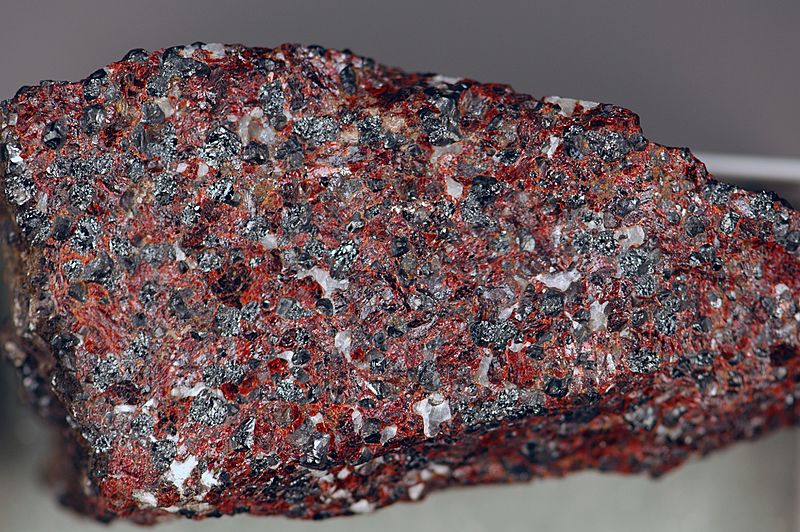Image: Zincite-franklinite-calcite rock (zinc ore), Sterling Hill NJ

Description: Zinc ore (= zincite-franklinite-calcite rock) (~6.2 cm across) Significant zinc ore bodies in the Franklin Marble of Mesoproterozoic age have been mined in northern New Jersey, USA for many decades. Zinc ores from the Sterling Hill and Franklin areas of New Jersey are dominated by red zincite (ZnO - zinc oxide) and black franklinite ((Zn,Fe)Fe2O4 - zinc iron oxide). The New Jersey zincite-franklinite bodies are traditionally considered as skarn deposits - the result of contact metamorphism of Cambro-Ordovician limestones by igneous intrusions. Elsewhere, igneous intrusion of limestones does result in the formation of odd mineral suites by contact metamorphism. However, these zinc ores do not appear to be skarn deposits. Their exact origin is still debated in the literature, but published research suggests that the zinc ore bodies were originally Zn-rich metalliferous sediments deposited in the margin of a marine basin. The marine basin was subsequently metamorphosed by subduction during the Grenville Orogeny (1.03-1.08 billion years ago) and became enclosed in marble host rocks by inverse diapirism. In addition to their economic geologic significance, the rocks and minerals from the Franklin and Sterling Hill zinc orebodies of New Jersey are famous for their gorgeous fluorescent colors under ultraviolet (UV) light. In addition to franklinite and zincite, which don't fluoresce, many rocks from the New Jersey zinc mines are rich in calcite (CaCO3 - calcium carbonate), plus some willemite (Zn2SiO4 - zinc silicate), both of which fluoresce. Under normal light, the calcite is whitish-grayish in color. Under UV light, manganiferous calcite will fluoresce an intense orangish-red color. Willemite varies considerably in normal light, but is usually light brown to peachy-colored in New Jersey zinc ores. Under UV light, willemite will always have an intense greenish fluorescence. Why do some minerals fluoresce under UV light? When short-wavelength UV radiation, long-wavelength UV radiation, or x-rays bombard atoms, electron excitation occurs. But the electrons do not remain in an energetically excited state. They quickly give off energy and resume their normal energy levels. If the electron energy release is in the visible spectrum of light, a mineral glows, or fluoresces.
Title: Zincite-franklinite-calcite rock (zinc ore), Sterling Hill NJ
Credit: Zincite-franklinite-calcite rock (zinc ore) (Franklin Marble, Mesoproterozoic, 1.03-1.08 Ga; zinc mine in town of Sterling Hill, northern New Jersey, USA) 1
Author: James St. John
Usage Terms: Creative Commons Attribution 2.0
License: CC BY 2.0
License Link: http://creativecommons.org/licenses/by/2.0
Attribution Required?: Yes
Image usage
The following page links to this image:

